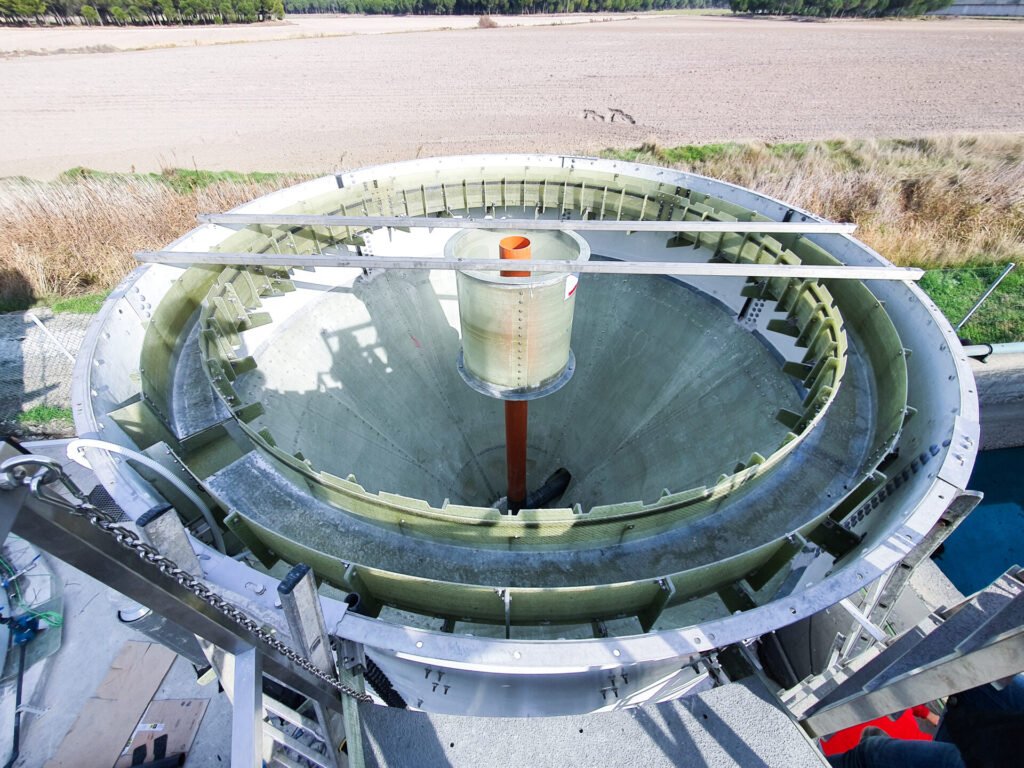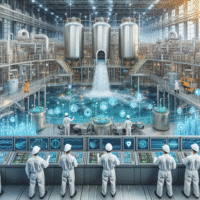Circular Clarifiers in Wastewater: Essential Components for Water Treatment Efficiency

Circular clarifiers are a critical component in the wastewater treatment process, serving an essential function in both municipal and industrial treatment systems. They are designed primarily to remove solid particulates by sedimentation. The process exploits the density difference between the suspended solids and water, allowing the solids to settle at the bottom of the tank, which is then raked or pumped out for further processing or disposal.
The engineering of circular clarifiers involves careful consideration of various factors to ensure efficient separation and treatment. Factors such as the size, geometry, and flow dynamics are tailored to meet the specific requirements of a treatment facility. Performance and optimization are of utmost importance, as they directly affect the quality of the effluent. Innovations and technological advances continually improve clarifier function, meeting increasingly stringent regulations and standards intended to protect environmental and public health.
Key Takeaways
- Circular clarifiers play a vital role in removing solids from wastewater via sedimentation.
- Design and performance optimizations in clarifiers enhance treatment quality and efficiency.
- Technological advancements support compliance with evolving environmental regulations.
Basics of Wastewater Treatment
Wastewater treatment is a critical process where contaminants are removed from water before it is released back into the environment or reused. The main goal is to protect water quality and ensure public health and environmental safety. Treatment involves several stages, ranging from preliminary to advanced processes.
Preliminary treatments typically remove large solids through screening and grit removal. Following this, primary treatment settles out suspended solids. In secondary treatment, biological processes break down dissolved organic matter. Advanced treatments may include nutrient removal or disinfection.
Circular clarifiers play a vital role in the primary and secondary stages. They are commonly as sedimentation tanks. Their design promotes efficient solid-liquid separation. The clarifiers are equipped with a slowly revolving arm. This device is essential, as it gently pushes the settled solids towards the center for removal, which significantly enhances the clarity of the effluent.
- Typical components of circular clarifiers include:
- A circular tank
- A central inlet
- A rotating bridge with scrapers
- A peripheral weir for effluent discharge
Their operation is based on gravity, with solids settling to the bottom due to their higher density. The design ensures even distribution of wastewater and prevents short-circuiting. Circular clarifiers are known for their reliability, simplicity of operation, and efficient use of space, making them a staple in wastewater treatment plants.
Design and Engineering of Circular Clarifiers
Circular clarifiers are a pivotal component in wastewater treatment plants, designed to slow the wastewater flow for suspended solids to settle. These structures are complex and require precise design considerations to effectively separate solids from liquids.
Hydraulic Design
The hydraulic design of circular clarifiers is critical to their performance. It revolves around ensuring a uniform flow pattern that minimizes turbulence and maximizes settling. Two key aspects are the weir loading rate and the surface overflow rate. The weir loading rate affects the effluent quality, while the surface overflow rate influences the rate at which particles settle. Specific parameters for these rates are derived from empirical data and are adjusted based on the characteristics of the wastewater and settled solids.
- Weir Loading Rate: Determines effluent quality.
- Surface Overflow Rate: Affects settling efficiency.
Structural Design
The structural design of circular clarifiers involves the consideration of materials, stability, and the ability to withstand loads. The clarifier must be constructed with durable materials resistant to corrosion and capable of withstanding the aquatic and chemical environment of wastewater. The tank walls and the conical sludge-holding bottom need to be reinforced to prevent failure.
- Materials: Resistance to corrosion is essential.
- Reinforcement: Ensures longevity and durability under load.
Mechanical Components
Mechanical components of circular clarifiers include rakes, drives, and scum skimmers. The sludge rakes are crucial; they move settled solids towards the center for removal, operating with a drive mechanism that controls the sludge removal rate. Additionally, scum skimmers remove floating solids from the water surface.
- Sludge Rakes: Move settled solids to ensure continuous operation.
- Drive Mechanism: Regulates the removal rate of sludge.
- Scum Skimmers: Clear surface from floatable debris.
The design and engineering of circular clarifiers are paramount for their performance in separating solids during wastewater treatment. Each component of their design must ensure efficiency, durability, and adaptability to varying wastewater characteristics.
Types of Circular Clarifiers
Circular clarifiers in wastewater treatment are essential for separating solids from liquids. They are generally categorized into two main types, each serving a distinct process within the treatment sequence.
Primary Clarifiers
Primary clarifiers are the first step in the solid-liquid separation process. They operate by slowing the wastewater down to facilitate the settling of solid particles, known as sludge. This process takes place before the biological treatment phase and is crucial for removing coarse solids that could hinder subsequent treatment stages.
- Design Considerations: Typical designs include a circular tank with a rotating sludge scraper at the bottom.
- Usage: Often employed in municipal wastewater treatment where large volumes require efficient processing.
Secondary Clarifiers
Secondary clarifiers follow the biological treatment processes, such as activated sludge systems, and serve to further separate the biological floc or biomass from the treated water. The mechanism is similar to the primary clarifier, but it deals with finer particles that have been formed during the biological process.
- Design Considerations: They also typically comprise a circular tank but with mechanisms tailored to handle lighter, more biochemically active sludge.
- Usage: These clarifiers are essential for achieving the required clarity and quality of effluent before it can be discharged or subjected to further treatment.
Clarifier Performance and Optimization
Proper performance and optimization of circular clarifiers are essential in wastewater treatment processes. These systems must be fine-tuned to achieve maximum efficiency in removing solids and maintaining water quality.
Process Efficiency
Circular clarifiers in wastewater treatment are designed to facilitate the separation of solids from the liquid. The efficiency of these clarifiers is largely dependent on several factors including hydraulic loading rate, solids loading rate, and detention time. For optimal performance, it’s crucial to maintain a balance between these factors. An ideal floor slope of 2-3 inches per foot can significantly enhance the sedimentation process, as highlighted in the Tennessee Government’s wastewater design criteria.
Parameters such as flow distribution and clarifier geometry play vital roles in process efficiency. They must be properly configured to ensure uniform distribution of the incoming flow and to prevent short-circuiting. Adjustments to weir settings can also influence the clarity of the effluent, to achieve the clearest water possible as it exits the basin.
Troubleshooting and Maintenance
Timely troubleshooting and maintenance are pivotal for the longevity and effectiveness of circular clarifiers. One must monitor for common issues such as sludge build-up, irregular sludge blanket levels, and inefficient solids removal—all of which can impair clarifier function. Regular inspection can reveal wear and tear on components like scrapers and drive mechanisms, necessitating prompt maintenance or repairs.
Effective maintenance strategies include routine clearing of influent channels, examination and repair of mechanical components, and cleaning of weirs and baffles. Proper maintenance ensures that clarifiers operate within their optimal capacity, thus reducing the need for costly repairs and downtime. Documenting performance metrics and maintaining a log of maintenance activities can aid in identifying patterns or recurring issues, which can, in turn, inform targeted interventions to optimize the clarifier function.
Regulations and Standards
Circular clarifiers are essential components in wastewater treatment plants. They operate under strict regulations and standards to ensure that the treated water meets environmental safety requirements.
Local Guidelines
Local guidelines for circular clarifiers are established by municipal or regional authorities and vary based on the specific needs of the area. For instance, they dictate the design flow rates, settling times, and effluent quality to address local water quality concerns. Local construction and safety codes also impact the materials and processes used in the construction of circular clarifiers.
National Standards
At the national level, standards for circular clarifiers in wastewater treatment are developed by agencies such as the United States Environmental Protection Agency (EPA). The EPA provides oversight on the overall framework for wastewater treatment and sludge management. National standards set the minimum requirements for effluent discharge, including the acceptable levels of nutrients and contaminants. These regulations aim to protect the health of the public and the environment by ensuring that wastewater is adequately treated before being discharged.
Innovations and Technological Advances
Circular clarifiers have been a fundamental part of wastewater treatment for decades. Recent innovations in this technology focus on enhancing efficiency and reducing the environmental footprint.
Advances in Design:
- Improved Inlet Structures: State-of-the-art inlet designs manage flow more effectively, reducing turbulence and improving solids settlement.
- Energy-efficient Features: Advances, such as low-energy mixers and optimized rake mechanisms, reduce power consumption.
Enhanced Treatment Processes:
- Real-time Monitoring: The use of sensors and control systems allows for the real-time adjustment of clarifier operations, ensuring optimal performance.
- Smart Sludge Management: Automated sludge removal systems are more precise, preventing excess sludge build-up and enhancing effluent quality.
Several technological advances have been made in the area of describing extracellular polymeric substances that play a role in the separation process during wastewater treatment. Understanding their impact on floc structure helps in improving the clarifier designs.
Material Innovations:
- Advanced Coatings: The use of new, more durable materials for tank surfaces aids in longevity and maintenance costs.
- Improved Scrapers: Redesigned scraper blades offer better solids collection with less wear.
These advancements not only cater to the efficiency of circular clarifiers in wastewater treatment but also encourage sustainability in water resource management. The integration of new materials and smart technologies signifies a step towards future-proofing wastewater infrastructure and optimizing water treatment processes.
Frequently Asked Questions
What are the primary differences between primary and secondary clarifiers in wastewater treatment?
Primary clarifiers focus on removing suspended solids and organic matter through sedimentation, while secondary clarifiers are designed to separate biological floc or sludge generated from secondary biological treatment processes.
How do the designs of mechanical and hydraulic circular clarifiers differ?
Mechanical circular clarifiers utilize rotating mechanical equipment to facilitate sludge collection, while hydraulic clarifiers rely on the natural flow of water and gravitational forces to collect and remove settled solids.
What are the common parts and functions of a circular clarifier?
Circular clarifiers typically contain a feed well for wastewater distribution, a clarifying zone where particle sedimentation occurs, a collection system for settled solids, and a mechanism for clarified water collection.
How is the efficiency of circular clarifiers affected by their design parameters?
The efficiency of clarifiers is influenced by various design parameters, including the clarifier's diameter, depth, surface loading rate, and weir overflow rate, all of which affect the settling time and removal efficiency of solids.
In what ways do rectangular and circular clarifiers differ in performance and application?
Rectangular clarifiers are often favored for their ease of integration into existing spaces, but circular clarifiers are generally more efficient in terms of space utilization and energy consumption due to their symmetrical flow pattern.
What critical calculations are involved in the design of a circular clarifier?
Critical calculations in the design of a circular clarifier include determining the surface area needed for effective settling, the volume of sludge to be handled, the hydraulic loading rate, and the detention time to ensure optimal performance.

